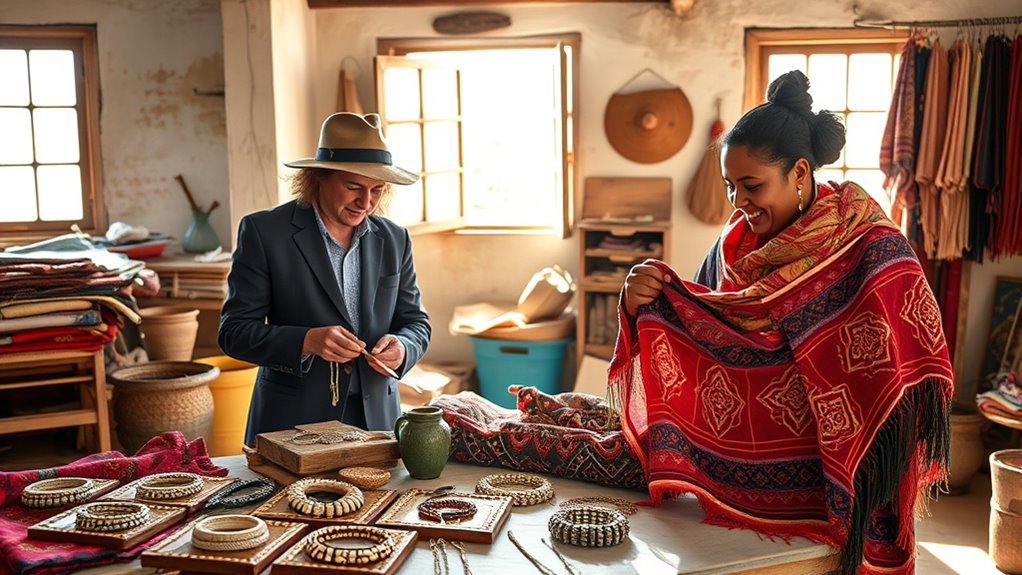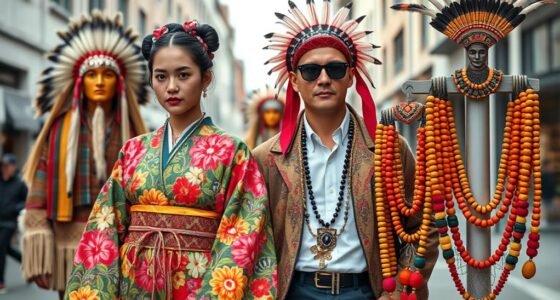When Western designers team up with global artisans, they create unique collaborations that blend traditional techniques with modern styles. This cultural exchange not only celebrates craftsmanship and heritage but also fosters innovation and sustainability. By sharing stories and respecting authentic practices, these partnerships support artisan communities and promote ethical practices. If you want to discover how these collaborations are shaping the future of design and cultural preservation, there’s more to explore ahead.
Key Takeaways
- Cross-cultural collaborations foster innovation by blending diverse design techniques and cultural motifs, enriching products with authentic storytelling.
- Western designers partnering with global artisans promote cultural exchange, mutual respect, and appreciation of traditional craftsmanship.
- These collaborations support artisan communities, helping preserve cultural heritage and ensuring sustainable livelihoods.
- Integrating traditional techniques into modern designs enhances market relevance and celebrates cultural identity.
- Transparency and ethical practices in sourcing and storytelling ensure respectful representation and cultural preservation.
Bridging Traditions: The Power of Cultural Exchange
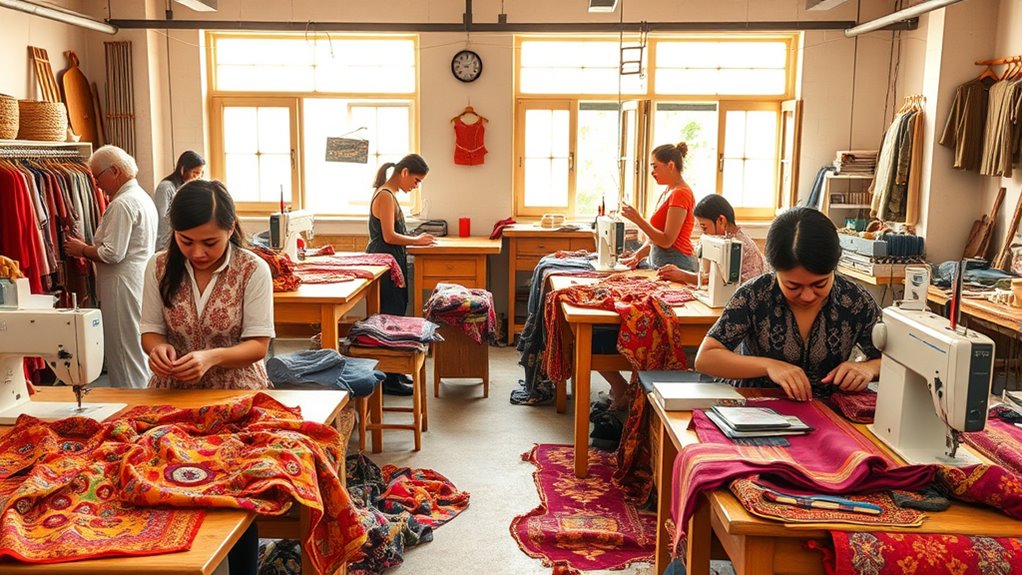
Cultural exchange has the remarkable ability to unite diverse traditions and create a shared understanding between communities. By engaging in fusion markets, you open doors to blending different design elements, fostering innovation rooted in tradition. This process exemplifies design diplomacy, where collaborative efforts promote mutual respect and cultural appreciation. When Western designers work alongside global artisans, they incorporate local motifs and techniques, enriching the final product. These exchanges do more than produce unique items; they build bridges that strengthen relationships and break down stereotypes. Through this dynamic exchange, you participate in a dialogue that celebrates diversity while creating something new and meaningful. Ultimately, cultural exchange nurtures a global community where traditions evolve through collaboration, making shared appreciation the heart of cross-cultural partnerships. Recognizing the importance of cultural preservation ensures that these collaborations honor the integrity of traditional craftsmanship while fostering innovation. Additionally, understanding the significance of traditional techniques allows designers to authentically incorporate cultural elements into contemporary designs, and embracing cross-cultural collaboration can lead to groundbreaking creative outcomes.
Showcasing Unique Techniques and Craftsmanship
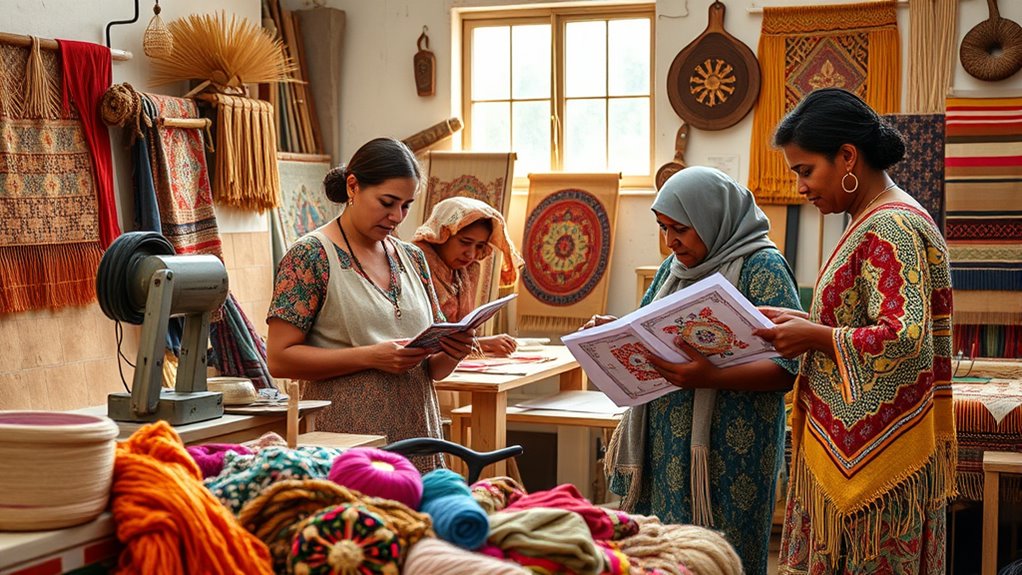
You’ll see how different cultures highlight their unique techniques and craftsmanship to create stunning, authentic pieces. These methods carry deep cultural meaning and showcase incredible skill. Celebrating these traditions helps preserve heritage while inspiring new creative expressions. For example, traditional craftsmanship techniques can be integrated into modern designs, creating a bridge between the old and the new. Recognizing the cultural heritage embedded in these art forms emphasizes their importance for identity and community cohesion. Incorporating artistic traditions into contemporary work fosters appreciation for diverse cultural narratives and supports the sustainability of artisan practices.
Cultural Heritage Techniques
Have you ever marveled at the intricate patterns and techniques that define traditional craftsmanship? These cultural heritage techniques hold stories and meanings passed down through generations. Textile preservation is essential, ensuring ancient fabrics and weaving methods remain intact, often using natural dyes and hand-spinning techniques unique to each culture. Ritual symbolism plays a fundamental role, with designs and motifs representing spiritual beliefs, social status, or community identity. When Western designers collaborate with global artisans, they gain access to these authentic methods, blending tradition with modern creativity. Respecting and showcasing these techniques not only celebrates craftsmanship but also helps preserve cultural identity. By integrating such heritage techniques, collaborations become more meaningful, honoring the rich history embedded in each piece.
Authentic Craftsmanship Showcase
Showcasing authentic craftsmanship offers a powerful window into the skill and artistry behind traditional techniques. When you highlight these methods, you celebrate fusion aesthetics and design diversity, blending cultural influences seamlessly. To truly appreciate this craftsmanship, look for:
- Intricate handwork that reflects centuries-old traditions, showcasing unique techniques passed down through generations.
- Materials sourced locally, emphasizing sustainability and cultural significance.
- Innovative adaptations where artisans incorporate modern elements without losing authenticity.
Inspiring Innovation Through Diverse Perspectives
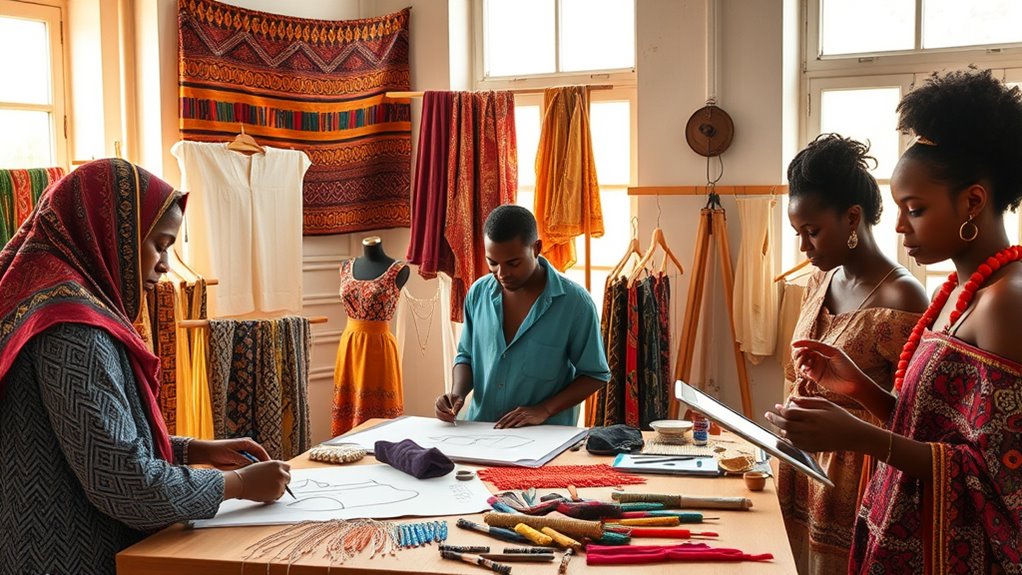
Diverse perspectives serve as a powerful catalyst for innovation, fueling fresh ideas and creative solutions that might not emerge within homogenous groups. When you embrace different cultural viewpoints, you open opportunities for fashion fusion and collaborative creativity. This blending sparks unique designs that stand out in the market and push boundaries. By working with global artisans, you gain insights that challenge conventional thinking, inspiring innovation at every turn. Cultivating an entrepreneurial mindset can further enhance these collaborations by encouraging continuous learning and risk-taking, leading to even more groundbreaking results. Recognizing the importance of market trends in diverse markets ensures that designs resonate globally and sustain relevance over time. Additionally, understanding cultural exchange can deepen the authenticity and appeal of collaborative collections.
Sustainability and Ethical Practices in Cross-Cultural Projects

As cross-cultural collaborations grow, prioritizing sustainability and ethical practices becomes essential to guarantee that innovation benefits both people and the planet. You should focus on fair trade to ensure artisans receive fair wages and support their communities. Material sourcing is equally crucial; choose eco-friendly and locally sourced materials to reduce environmental impact. To stay ethical, consider these steps: 1. Partner with suppliers committed to fair trade principles 2. Use sustainable materials that respect local ecosystems 3. Promote transparency in sourcing and production processes which can be supported by understanding the importance of ethically sourced products from the for-sale market. Incorporating raw food practices into the supply chain can further enhance sustainability efforts by reducing processing waste and promoting natural resource use. Additionally, understanding the role of sustainable material sourcing helps ensure that projects are environmentally responsible and culturally respectful.
Celebrating Authentic Stories and Cultural Heritage
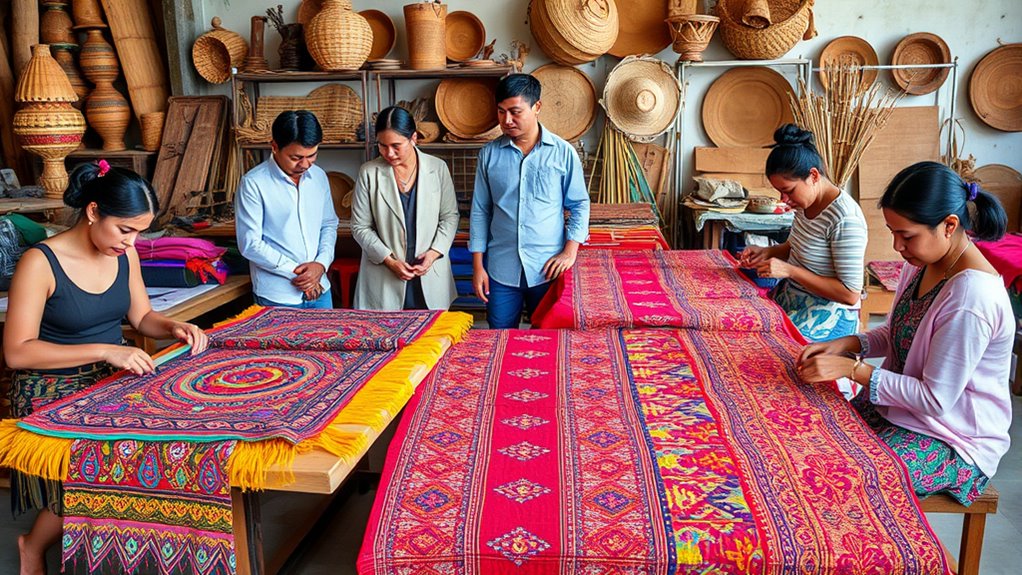
You can make a real impact by highlighting authentic stories and cultural heritage in your collaborations. When you preserve traditions and empower artisan communities, you help keep these cultures alive and thriving. Sharing genuine narratives allows others to appreciate and respect the richness behind each craft. Incorporating self watering plant pots into your designs can also demonstrate sustainable practices that honor traditional craftsmanship. Emphasizing cultural authenticity in your projects ensures that the unique identities of artisan communities are respected and celebrated. Developing cultural intelligence can further enhance your ability to navigate and honor diverse cultural contexts effectively.
Preserving Cultural Traditions
How can celebrating authentic stories and cultural heritage guarantee that traditions endure in a rapidly globalizing world? By emphasizing cultural identity and artistic authenticity, you help preserve unique customs and stories that define communities. This approach guarantees that traditions stay alive and relevant. Utilizing transparency in cultural storytelling ensures that the origins and significance of traditional crafts are properly conveyed and respected.
Here are three ways to do this:
- Share stories behind crafts, techniques, and symbols, making them meaningful and memorable.
- Collaborate with artisans to maintain traditional methods, honoring their cultural roots.
- Incorporate authentic elements into modern designs to keep traditions visible and appreciated.
Empowering Artisan Communities
Empowering artisan communities begins with recognizing the value of their authentic stories and cultural heritage. When you celebrate these traditions, you foster artisan entrepreneurship, enabling artisans to turn their skills into sustainable livelihoods. Supporting their craft not only sustains cultural practices but also boosts local economies. By engaging in cultural diplomacy, you promote mutual respect and understanding between communities, transforming craft into a bridge for global connection. Your efforts help artisans gain recognition, access new markets, and preserve their unique identities. This empowerment encourages them to innovate while honoring their roots. Additionally, cultivating attention during these collaborations can deepen cultural exchanges and strengthen community bonds. Recognizing the importance of cultural heritage can further inspire meaningful and respectful partnerships. Ultimately, celebrating authentic stories through cross-cultural collaborations ensures that cultural heritage remains vibrant, meaningful, and impactful for generations to come. Incorporating positive energy into these initiatives can further amplify their success and sustainability.
Sharing Authentic Narratives
Sharing authentic narratives plays a crucial role in highlighting the cultural significance behind artisan creations. When you tell these stories, you create a deeper connection with the audience and showcase the fusion aesthetics that make each piece unique. Your storytelling impact can transform simple products into meaningful symbols of heritage. To do this effectively:
- Highlight the artisan’s background and the traditions behind their craft.
- Emphasize the cultural symbols embedded in the design.
- Share the journey of the piece from concept to creation, illustrating its cultural importance.
- Incorporate well-being tips that promote understanding and appreciation of diverse cultural practices, enriching the storytelling experience. Recognizing the importance of emotional intelligence can deepen the narrative and foster genuine appreciation for the artisans’ cultural expressions. Additionally, understanding cultural heritage helps to preserve and honor the traditions that inspire these unique collaborations.
Future Trends in Global Collaborative Design
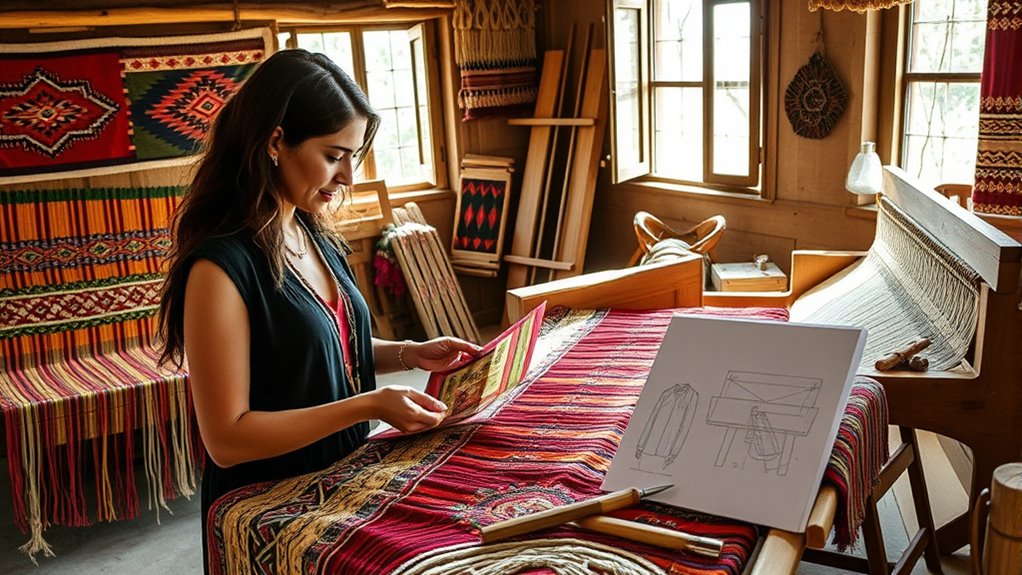
As technology continues to evolve, future trends in global collaborative design will increasingly emphasize seamless connectivity and real-time communication. You’ll see digital collaborations becoming more intuitive, allowing designers and artisans from different cultures to work together effortlessly across time zones. This shift facilitates faster iteration and innovation, making project timelines shorter and more flexible. Market expansion will also play a pivotal role, as brands leverage global networks to reach new audiences and tap into diverse markets. By embracing these trends, you’ll be able to create culturally rich, authentic products that resonate worldwide. The integration of advanced communication tools will foster stronger partnerships, empowering you to navigate cross-cultural differences and develop truly global designs efficiently and effectively. Additionally, digital tools will continue to improve, enabling more precise and culturally sensitive collaborations. Leveraging asset division strategies can help manage resources effectively in international projects, ensuring fair contribution and benefit sharing across diverse teams.
Frequently Asked Questions
How Do Designers Ensure Respectful Collaboration Without Cultural Appropriation?
You guarantee respectful collaboration by practicing cultural sensitivity and understanding the significance of traditional designs. You engage with artisans directly, listen to their stories, and honor their craftsmanship. Ethical sourcing is key—pay fair wages and avoid exploiting cultural symbols. By prioritizing transparency, respecting local customs, and fostering genuine partnerships, you create designs that celebrate cultural heritage without appropriating it. This approach promotes mutual respect and authentic artistic exchange.
What Are Common Challenges Faced During Cross-Cultural Design Partnerships?
You face common challenges like managing cultural sensitivity and overcoming communication barriers. These issues can lead to misunderstandings, misinterpretations, or unintentional disrespect. You might struggle to align expectations, honor local traditions, and guarantee mutual respect. Clear, open communication and deep cultural awareness are essential. You need to actively listen, ask questions, and collaborate authentically to build trust and create respectful, meaningful partnerships across diverse cultural contexts.
How Do Pricing and Profit-Sharing Work in These Collaborations?
You need to guarantee fair compensation and transparent agreements in collaborations. Pricing should reflect artisans’ skills, materials, and effort, while profit-sharing must be clearly defined upfront. Open communication helps prevent misunderstandings, ensuring everyone benefits fairly. By establishing these principles early, you foster trust and respect, creating a successful partnership. Ultimately, fair pricing and transparent profit-sharing support long-term collaboration and uphold the integrity of all involved.
How Is Intellectual Property Protected Across Different Legal Systems?
Think of legal frameworks as the compass guiding your creative journey across borders. You need to navigate cultural sensitivities and different legal systems to protect your intellectual property effectively. Establish clear agreements that respect local laws and cultural nuances. By doing so, you guarantee your designs stay secure, fostering trust and mutual respect. Remember, safeguarding ideas isn’t just legal—it’s about honoring the diverse cultures you collaborate with.
What Role Does Customer Feedback Play in Shaping These Projects?
Customer feedback plays a pivotal role in shaping your projects by providing insights into market research and consumer preferences. As you gather opinions, you can adapt your designs to better meet your audience’s needs, ensuring relevance and appeal. Listening actively helps you identify trends, address concerns, and refine your work, ultimately creating products that resonate more deeply with your target market and foster stronger connections with consumers.
Conclusion
As you explore these cross-cultural collaborations, remember the timeless wisdom of Marco Polo—bridging worlds leads to discovery and innovation. By embracing diverse traditions and stories, you become part of a vibrant tapestry that celebrates authenticity and craftsmanship. Let these partnerships inspire you to foster understanding, sustainability, and creativity. Just as ancient explorers expanded horizons, your openness to global artisans can shape a more connected and inspired future in design.
